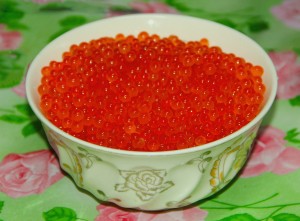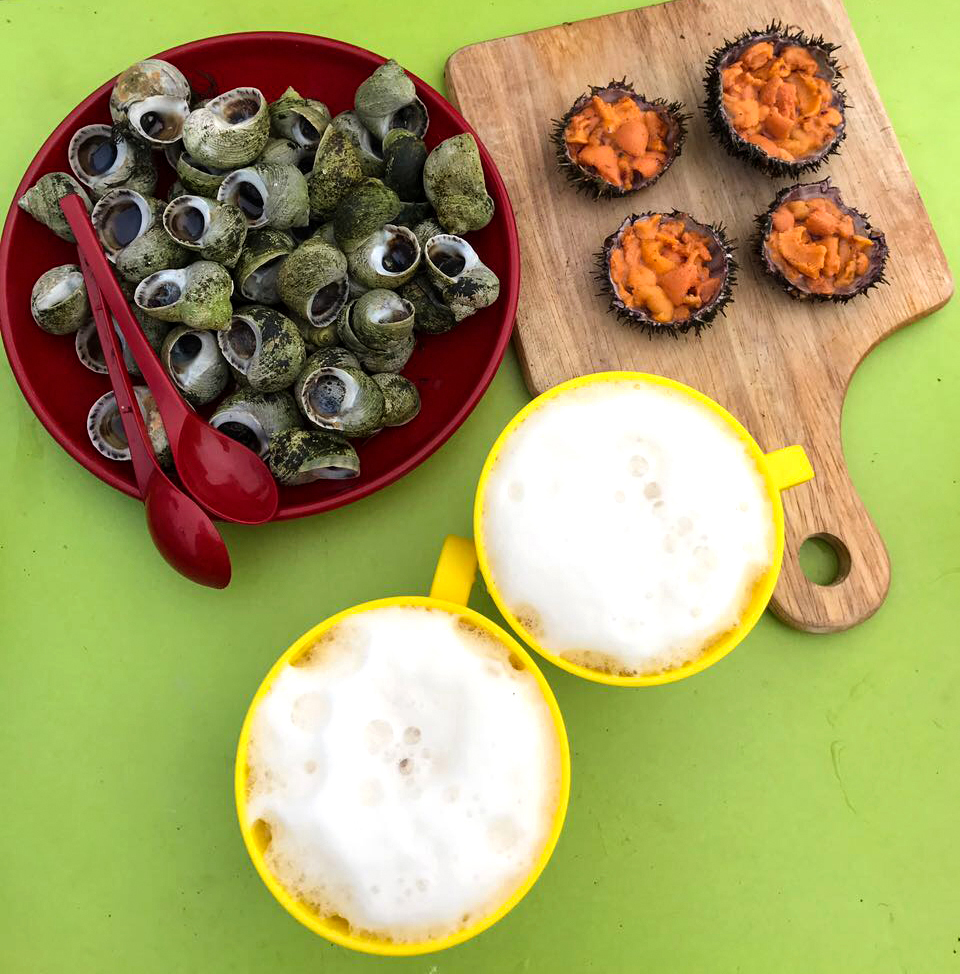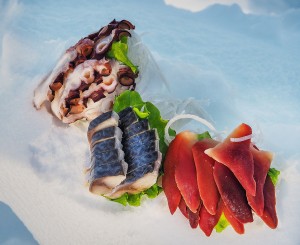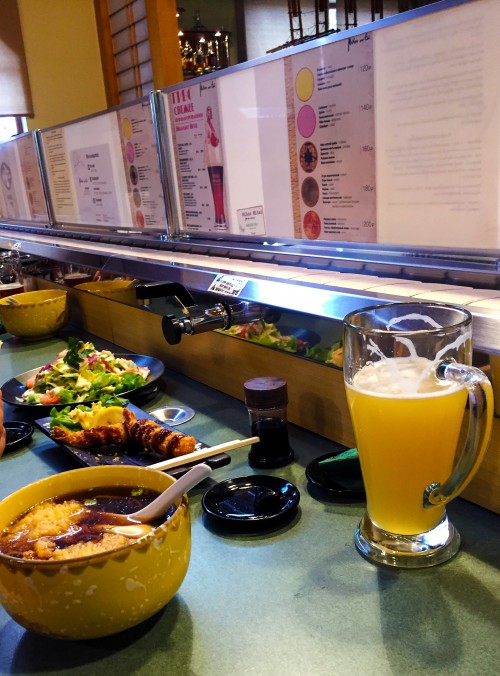Sakhalin, it's not only beautiful, but also very tasty!
As is known, it was the Japanese and Russians who first began to develop the island rich in seafood and strange savages, and in the distant 1855 Sakhalin was recognized as the territory of joint development of the Russian Empire and the Land of the Rising Sun. In subsequent years, as a result of the fierce struggle for control over this rich natural land, the two powers became successively the owners of the island, first, in 1875, Russia obtained all rights to Sakhalin in exchange for the Japanese refusal from the Kuril Islands, and as early as 1905 as a result of the defeat of Russia in the Russo-Japanese War, the South of Sakhalin first withdrew to Japan, and then, from 1918 to 1925, the Japanese became the sole owners of the Island. During the occupation, the Japanese imported tens of thousands of Koreans as cheap labor. The final point in the ownership of the island was set by the victory of the USSR in 1945 over Japan in the Second World War. And if in the next few years the majority of the Japanese population was evicted from the island, the Koreans remained almost full-time on Sakhalin and by now the Korean make up the second largest national community of the island. In this way, historically neighboring and integrating, the national cuisines of the three nations brought to light the unique Sakhalin cuisine influenced by the Japanese culinary traditions with abundant fish, shellfish and other seafood in a compartment with sharp wild plants and Korean cabbage kimchi inherited from the gastronomic predilections of Sakhalin Koreans.
In subsequent years, as a result of the fierce struggle for control over this rich natural land, the two powers became successively the owners of the island, first, in 1875, Russia obtained all rights to Sakhalin in exchange for the Japanese refusal from the Kuril Islands, and as early as 1905 as a result of the defeat of Russia in the Russo-Japanese War, the South of Sakhalin first withdrew to Japan, and then, from 1918 to 1925, the Japanese became the sole owners of the Island. During the occupation, the Japanese imported tens of thousands of Koreans as cheap labor. The final point in the ownership of the island was set by the victory of the USSR in 1945 over Japan in the Second World War. And if in the next few years the majority of the Japanese population was evicted from the island, the Koreans remained almost full-time on Sakhalin and by now the Korean make up the second largest national community of the island. In this way, historically neighboring and integrating, the national cuisines of the three nations brought to light the unique Sakhalin cuisine influenced by the Japanese culinary traditions with abundant fish, shellfish and other seafood in a compartment with sharp wild plants and Korean cabbage kimchi inherited from the gastronomic predilections of Sakhalin Koreans.
At the same time, if the Japanese cuisine is familiar to a wide range of Russian residents not by hearsay (although such a level of freshness of seafood and mastery of chefs trained in the best Japanese restaurants as on Sakhalin remains for the most part of Russia inaccessible), then in Korean cuisine, not so widely known connoisseurs. For almost a centurynow, carefully, from generation to generation, recipes of dishes have been handed over. 
It was these dishes that stood on the tables in Korean houses at the end of the previous and the beginning of the last centuries. According to the guests from DPRK and South Korea, the Korean population on Sakhalin managed to preserve many features of the national cuisine that partly changed or were lost on the Korean peninsula. A characteristic feature of Korean national cuisine is also the fact that most of the products used in cooking are most often taken fresh or thermally processed for a short time. Overcooked or overcooked foods will not allow you to get a dish of the right quality. On Sakhalin, they love and know how to cook Korean national dishes, so wherever you go, you will not be disappointed.
As for Japanese cuisine, the geographic location of the Sakhalin region, the proximity of the countries of the Asia-Pacific region, the diversity of aquatic biological resources make our island a gastronomic "mecca" for sushi lovers, sashimi, rolls and hundreds of other dishes so popular in the Land of the Rising Sun and so same as ours. The freshness of ingredients, the technology of cooking, the art of filing and the skill of Sakhalin cooks, many of which were practiced by masters from a neighboring country, make Japanese cuisine on Sakhalin not just authentic, but real - truly Japanese.  The thrill with which the Sakhalin people relate to the traditions of Japanese gastronomy, can characterize the fact that the owner of one of the best restaurants in the city, Yutaka Miyanisi, became an honorary resident of Yuzhno-Sakhalinsk. Another of our pride is smelt. Fresh, this fish smells like cucumbers. The most delicious - just caught and fried right on the ice. Dried - an irreplaceable snack for beer. A separate line I would like to say about Sakhalin crabs - succulent, fleshy, with pink inner Sakhalin crabs are good as a separate dish and as components of salads and soups. And of course, only on Sakhalin you will be able to taste the freshest freshly picked scallops, octopus, sea urchin eggs, spisula, mussels, buccinidae, squid, sea cucumber, shrimp, etc. As for the wild plants, only on Sakhalin you will be able to get enough of cloudberry, cranberries, blueberries, stone bramble, ferns, burdock, five-flavor berry and, of course, a unique berry – Kamchatka bilberry, which is called called “klopovka" or “the Berry bug”.
The thrill with which the Sakhalin people relate to the traditions of Japanese gastronomy, can characterize the fact that the owner of one of the best restaurants in the city, Yutaka Miyanisi, became an honorary resident of Yuzhno-Sakhalinsk. Another of our pride is smelt. Fresh, this fish smells like cucumbers. The most delicious - just caught and fried right on the ice. Dried - an irreplaceable snack for beer. A separate line I would like to say about Sakhalin crabs - succulent, fleshy, with pink inner Sakhalin crabs are good as a separate dish and as components of salads and soups. And of course, only on Sakhalin you will be able to taste the freshest freshly picked scallops, octopus, sea urchin eggs, spisula, mussels, buccinidae, squid, sea cucumber, shrimp, etc. As for the wild plants, only on Sakhalin you will be able to get enough of cloudberry, cranberries, blueberries, stone bramble, ferns, burdock, five-flavor berry and, of course, a unique berry – Kamchatka bilberry, which is called called “klopovka" or “the Berry bug”.
Having visited Sakhalin, you simply have to evaluate the most popular traditional dishes of the Island: pancakes with red salmon caviar, Korean snacks with buccinidae, Korean veal soup with real sea kale, Korean classic fish soup of hemultan based on halibut and six different seafood, a salad of burdock, a plant about which, incidentally, Anton Chekhov wrote: "Such huge burdlock as here, I have not seen anywhere in Russia ... at night in the moonlight they seem fantastic"… and cooked in Korean way is "fantastically tasty"…
